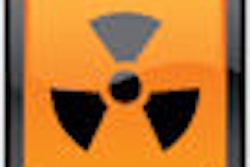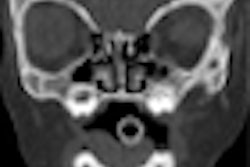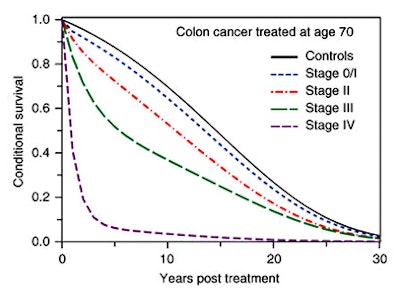
Patients with shorter life expectancies are at far less risk relative to those with a good prognosis when it comes to radiation dangers from medical imaging, conclude researchers in a new study in Radiology. The results may bring some relief to radiologists who feel that radiation risk has been overemphasized at the expense of clinical need.
A research team led by Dr. David Brenner from Columbia University found that sicker patients may have one-tenth the risk of cancer induction compared to healthier patients when it comes to radiation-based imaging exams. The findings should be taken into account when analyzing the risk-benefit ratio of when to perform an imaging exam.
"Reduced life expectancy is an important factor in determining the potential radiation-associated lifetime risk associated with radiologic examinations and thus should play a substantial role in assessing the justification and optimization of these examinations," Brenner and colleagues wrote.
The researchers calculated radiation doses from a wide range of commonly used CT exams, examining radiation-related lifetime lung cancer risk in patients with cancer or heart disease and comparing it to the same exams in individuals without disease in order to quantify the reduced life expectancy (Radiology, October 2011, Vol. 261:1, pp. 193-198).
Researchers focused on the risk of lung cancer caused by radiation in patients undergoing coronary CT angiography (CCTA) for multivessel disease, who were scanned prior to their coronary artery bypass graft (CABG) surgery, as well as in patients receiving colorectal cancer therapy. They used clinically determined life tables (mortality data after treatment for colon cancer or after CABG), and statistical uncertainties were estimated for these two types of patients and compared with the general population.
The authors estimated mortality from equations provided in the Biological Effects of Ionizing Radiation (BEIR) VII report. The BEIR VII estimates, because they rely on data from Japanese atomic bomb survivors that may not be the same in Western populations, were weighted by factors provided in the report.
Reduced risk
The results showed that patients with decreased life expectancy had reduced radiation-associated risks of cancer. In some cases, the level of risk reduction was stark. In the case of a 70-year-old patient with colon cancer, for example, the estimated reduction in lifetime radiation-associated lung cancer risk was approximately 92% for stage IV disease, versus an 8% reduction for a patient with stage 0 or I disease who was scanned.
For a patient who had been treated with CABG surgery, the estimated reduction in lifetime radiation-associated lung cancer risk was approximately 57% for a 55-year-old patient, compared with 12% for a 75-year-old, the authors reported.
"The importance of radiation exposure in determining optimal imaging usage is much reduced in patients with markedly reduced life expectancies," they wrote.
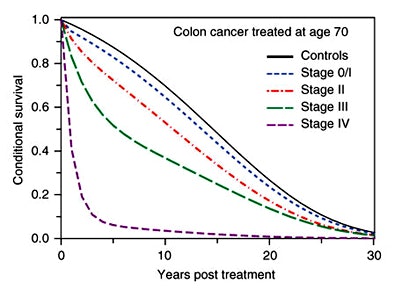 |
| Graph shows comparison of long-term conditional survival functions for patients diagnosed with different stages of colon cancer at age 70 years (the median age for colon cancer diagnosis) and for healthy control subjects. Derived from SEER results reported by Ward et al. Republished with permission of the RSNA from October 2011, Radiology, Vol. 261:1, pp. 193-198. |
However, they added, just as there are many conditions where life expectancies are reduced, permitting more leeway in radiation doses, there are many clinical scenarios where patients have the possibility of good life expectancy following their treatment; in these cases, any reduction in lifetime radiation risk will be minimal relative to the general population. Examples of conditions with a favorable prognosis where risk cannot be reduced significantly include early-stage breast cancers, prostate cancers, mild head trauma, appendicitis, and CT screening of asymptomatic individuals, the authors stated.
The limitations of the study mostly relate to the process of calculating radiation risk from atomic bomb survivor data, and adapting the data to known differences in a Western population, according to the group.
 |
| Graphs show a comparison of long-term conditional survival functions for patients who had undergone CABG surgery (solid line) and an age-, sex-, and location-matched control population (dashed line). Derived from results reported by Gao et al. Republished with permission of the RSNA from October 2011, Radiology, Vol. 261:1, pp. 193-198. |
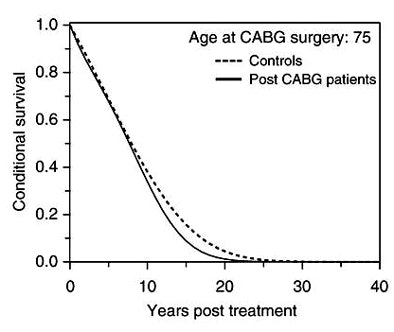 |
Life expectancy is an important factor in determining the potential radiation-associated lifetime risks of radiologic exams and "should play a substantial role in assessing the justification and optimization of these examinations," the authors concluded. "Estimates of radiation risks in reduced-life-expectancy scenarios that do not take this into account may well result in unrealistically large risk estimates."





